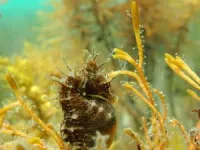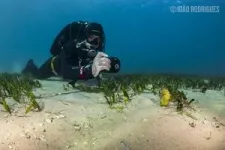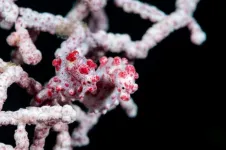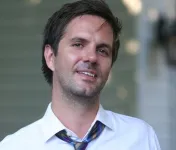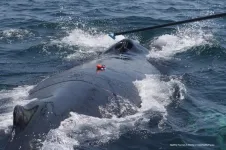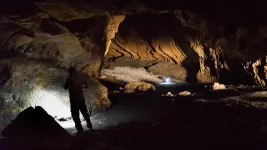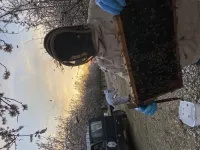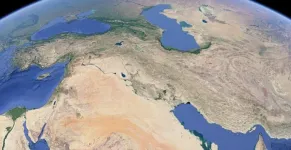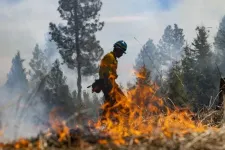(Press-News.org) Coastal seas form a complex transition zone between the two largest CO2 sinks in the global carbon cycle: land and ocean. Ocean researchers have now succeeded for the first time in investigating the role of the coastal ocean in a seamless model representation. The team led by Dr. Moritz Mathis from the Cluster of Excellence for Climate Research CLICCS at Universität Hamburg and the Helmholtz-Zentrum Hereon was able to show: The intensity of CO2 uptake is higher in coastal seas than in the open ocean. This is evidenced by a study published in the journal Nature Climate Change.
To counteract ongoing climate change, it is important to understand how CO2 emissions are distributed. And which exchange processes between the atmosphere, ocean and land regulate the distribution. Methodological developments in recent years have allowed for a more flexible inclusion of physical and biogeochemical processes in climate models and for capturing individual regions with higher resolution. Researchers from the Cluster of Excellence "Climate, Climatic Change, and Society" (CLICCS) have taken advantage of this. In collaboration between Helmholtz-Zentrum Hereon, Universität Hamburg, Max Planck Institute for Meteorology and University of Bern, they have developed a new type of ocean model that can efficiently simulate the transport, storage and turnover of carbon in the global coastal ocean for the first time: ICON-Coast.
More realistic representation
In computational climate science, land and ocean, the Earth's two major carbon reservoirs, have so far been considered separately. The transport of carbon into the coastal seas, for example via river inputs, coastal erosion and tidal flats, has been ignored. Coast-specific processes could only be considered in a limited and spatially coarse manner because climate models were developed for global scales. Due to the more realistic representation and higher resolution in the transition zone between land and ocean used in ICON-Coast, the model offers new possibilities to explore the effects of climate change on coastal areas and marine ecosystems, such as risks from heat waves, storms, or global sea level rise.
The coastal ocean is small but significant
It is known from observations that the increase in atmospheric CO2 concentration enhances the uptake of CO2 into the ocean, thereby significantly mitigating climate change. Simulations with ICON-Coast now shed light on the causes and enable understanding of the function of coastal and marginal seas in the Earth's climate dynamics: "Our analyses show that intense plankton growth is the key to enhanced CO2 uptake in the coastal ocean and that this uptake is higher than in the open ocean. This is due to climate-induced changes in the circulation and increasing nutrient inputs from rivers," says Dr Moritz Mathis, who led the study. The researchers also expect that the intensity difference between coastal seas and the open ocean will continue to strengthen further with ongoing CO2 emissions.
All the more important: "Coastal management strategies that disturb biological production could weaken the ocean's CO2 uptake and make climate protection more difficult," emphasizes Mathis. "With the new model, we can also test approaches to CO2 avoidance such as offshore wind energy for their effectiveness and undesirable side effects."
Further Information
Mathis, M., Lacroix, F., Hagemann, S., Nielsen, D. M., Ilyina, T., & Schrum, C. (2024). Enhanced CO2 uptake of the coastal ocean is dominated by biological carbon fixation. Nature Climate Change (in press) https://doi.org/10.1038/s41558-024-01956-w
Cluster of Excellence „Climate, Climatic Change, and Society” (CLICCS), Universität Hamburg https://www.cliccs.uni-hamburg.de
Hereon-Institute of Coastal Systems – Analysis and Modeling https://www.hereon.de/institutes/coastal_systems_analysis_modeling/index.php.en
Contact
Dr Moritz Mathis
Helmholtz-Zentrum Hereon, Institute of Coastal Systems – Analysis and Modeling
Cluster of Excellence “Climate, Climatic Change, and Society” (CLICCS)
+49 4152 87-2131, moritz.mathis@hereon.de, www.hereon.de
Ute Kreis
Universität Hamburg
Press and Public Relations
Cluster of Excellence “Climate, Climatic Change, and Society” (CLICCS)
Center for Earth System Research and Sustainability (CEN)
+49 40 42838 4523
ute.kreis@uni-hamburg.de
END
Breakthrough in modeling
First global study of coastal seas as carbon dioxide reservoirs possible
2024-03-25
ELSE PRESS RELEASES FROM THIS DATE:
Citizen scientists contribute vital information about 35 seahorse species: their geographic ranges, habitats, and pregnancy seasonality
2024-03-25
Thanks to diligent observers, seahorses, those enigmatic and charismatic fish, are not only being discovered in new habitats and expanded geographic ranges, they are also being found at new ocean depths. While their capacity for male pregnancy has long fascinated people, new information on sex ratio and pregnancy seasonality has been discovered by, well, you.
Researchers from Project Seahorse – a marine conservation team based at the University of British Columbia (UBC) and the Zoological Society of London (ZSL) – identified and reviewed new findings related to 35 of the 46 seahorse species found around the globe, ...
An effective method for improving energy storage performance in (Bi0.5Na0.5)TiO3-based lead-free relaxor ferroelectrics
2024-03-25
Next-generation advanced high/pulsed power capacitors urgently require dielectric materials with outstanding energy storage performance. (Bi0.5Na0.5)TiO3-based material, a typical lead-free ferroelectrics, has the characteristics of high polarization strength and excellent component compatibility, making it emerge as a potential candidate for energy storage applications.
Researchers have made an interesting breakthrough in the modification of the BNT-based ferroelectrics, an effective method for various properties such ...
Online dashboard to help fight to save children from deadly diarrheal diseases
2024-03-25
University of Virginia researchers are developing a flexible online tool for navigating information used in the fight to save children from deadly diarrheal diseases by identifying transmission hotspots and accelerating the deployment of treatments and new vaccines.
Diarrhea not only kills hundreds of thousands of children around the world every year, it contributes to malnutrition that can prevent kids from growing and developing to their full potential both physically and mentally, trapping them in poverty. While significant progress has been made against the disease in recent years, the UVA researchers say that ...
Caller ID of the sea
2024-03-25
For researchers studying the acoustic behavior of whales, distinguishing which animal is vocalizing is like a teacher trying to figure out which student responded first when the entire class is calling out the answer. This is because many of the techniques used to capture audio record a large sample size of sounds. A major example of this is passive acoustic monitoring (PAM), which records audio via a microphone in one location, usually a stationary or moving platform in the ocean. While this method allows researchers to gather acoustic data over a long time period, it ...
SwRI develops more effective particle conversion surfaces for space instruments
2024-03-25
SAN ANTONIO — March 25, 2024 —Southwest Research Institute is investing internal funding to develop more effective conversion surfaces to allow future spacecraft instruments to collect and analyze low-energy particles. Conversion surfaces are ultra-smooth, ultra-thin surfaces covering a silicon wafer that convert neutral atoms into ions to more effectively detect particles from outer space.
Changing the charge of particles simplifies and enhances detection and analysis capabilities. Dr. Jianliang Lin of the Institute’s Mechanical Engineering Division and Dr. Justyna Sokół of SwRI’s Space Science Division lead the multidisciplinary project. The project builds ...
Novel quantum algorithm for high-quality solutions to combinatorial optimization problems
2024-03-25
Combinatorial optimization problems (COPs) have applications in many different fields such as logistics, supply chain management, machine learning, material design and drug discovery, among others, for finding the optimal solution to complex problems. These problems are usually very computationally intensive using classical computers and thus solving COPs using quantum computers has attracted significant attention from both academia and industry.
Quantum computers take advantage of the quantum property of superposition, using specialized qubits, that can exist in an infinite yet contained number of states of 0 or 1 or any combination of the two, to quickly ...
Persian plateau unveiled as crucial hub for early human migration out of Africa
2024-03-25
A new study combining genetic, palaeoecological, and archaeological evidence has unveiled the Persian Plateau as a pivotal geographic location serving as a hub for Homo sapiens during the early stages of their migration out of Africa.
This revelation sheds new light on the complex journey of human populations, challenging previous understandings of our species' expansion into Eurasia.
The study, published in Nature Communications, highlights a crucial period between approximately 70,000 to 45,000 years ago when human populations did not uniformly spread across Eurasia, ...
Honey bees at risk for colony collapse from longer, warmer fall seasons
2024-03-25
PULLMAN, Wash. – The famous work ethic of honey bees might spell disaster for these busy crop pollinators as the climate warms, new research indicates.
Flying shortens the lives of bees, and worker honey bees will fly to find flowers whenever the weather is right, regardless of how much honey is already in the hive. Using climate and bee population models, researchers found that increasingly long autumns with good flying weather for bees raises the likelihood of colony collapse in the spring.
The study, published in Scientific Reports, focused on the Pacific Northwest but holds implications for hives across the U.S. The researchers ...
20,000 years of shared history on the Persian plateau
2024-03-25
All present day non African human populations are the result of subdivisions that took place after their ancestors left Africa at least 60.000 years ago. How long did it take for these separations to take place? Almost 20.000 years, during which they were all part of a single population. Where did they live for all this time? We don’t know, yet.
This is a conversation that could have taken place one year ago, now it is possible to give clearer answers to these questions thanks to the study recently published in Nature Communications (1) led by the researchers from the University ...
New UM study reveals unintended consequences of fire suppression
2024-03-25
MISSOULA – The escalation of extreme wildfires globally has prompted a critical examination of wildfire management strategies. A new study from the University of Montana reveals how fire suppression ensures that wildfires will burn under extreme conditions at high severity, exacerbating the impacts of climate change and fuel accumulation.
The study used computer simulations to show that attempting to suppress all wildfires results in fires burning with more severe ecological impacts, with accelerated increases in burned area beyond those expected from fuel accumulation or climate change.
“Fire suppression has unintended consequences,” said lead author Mark Kreider, a Ph.D. ...
LAST 30 PRESS RELEASES:
SIMJ announces global collaborative book project in commemoration of its 75th anniversary
Air pollution exposure and birth weight
Obstructive sleep apnea risk and mental health conditions among older adults
How talking slows eye movements behind the wheel
The Ceramic Society of Japan’s Oxoate Ceramics Research Association launches new international book project
Heart-brain connection: international study reveals the role of the vagus nerve in keeping the heart young
Researchers identify Rb1 as a predictive biomarker for a new therapeutic strategy in some breast cancers
Survey reveals ethical gaps slowing AI adoption in pediatric surgery
Stimulant ADHD medications work differently than thought
AI overestimates how smart people are, according to HSE economists
HSE researchers create genome-wide map of quadruplexes
Scientists boost cell "powerhouses" to burn more calories
Automatic label checking: The missing step in making reliable medical AI
Low daily alcohol intake linked to 50% heightened mouth cancer risk in India
American Meteorological Society announces Rick Spinrad as 2026 President-Elect
Biomass-based carbon capture spotlighted in newly released global climate webinar recording
Illuminating invisible nano pollutants: advanced bioimaging tracks the full journey of emerging nanoscale contaminants in living systems
How does age affect recovery from spinal cord injury?
Novel AI tool offers prognosis for patients with head and neck cancer
Fathers’ microplastic exposure tied to their children’s metabolic problems
Research validates laboratory model for studying high-grade serous ovarian cancer
SIR 2026 delivers transformative breakthroughs in minimally invasive medicine to improve patient care
Stem Cell Reports most downloaded papers of 2025 highlight the breadth and impact of stem cell research
Oxford-led study estimates NHS spends around 3% of its primary and secondary care budget on the health impacts of heat and cold in England
A researcher’s long quest leads to a smart composite breakthrough
Urban wild bees act as “microbial sensors” of city health.
New study finds where you live affects recovery after a hip fracture
Forecasting the impact of fully automated vehicle adoption on US road traffic injuries
Alcohol-related hospitalizations from 2016 to 2022
Semaglutide and hospitalizations in patients with obesity and established cardiovascular disease
[Press-News.org] Breakthrough in modelingFirst global study of coastal seas as carbon dioxide reservoirs possible

